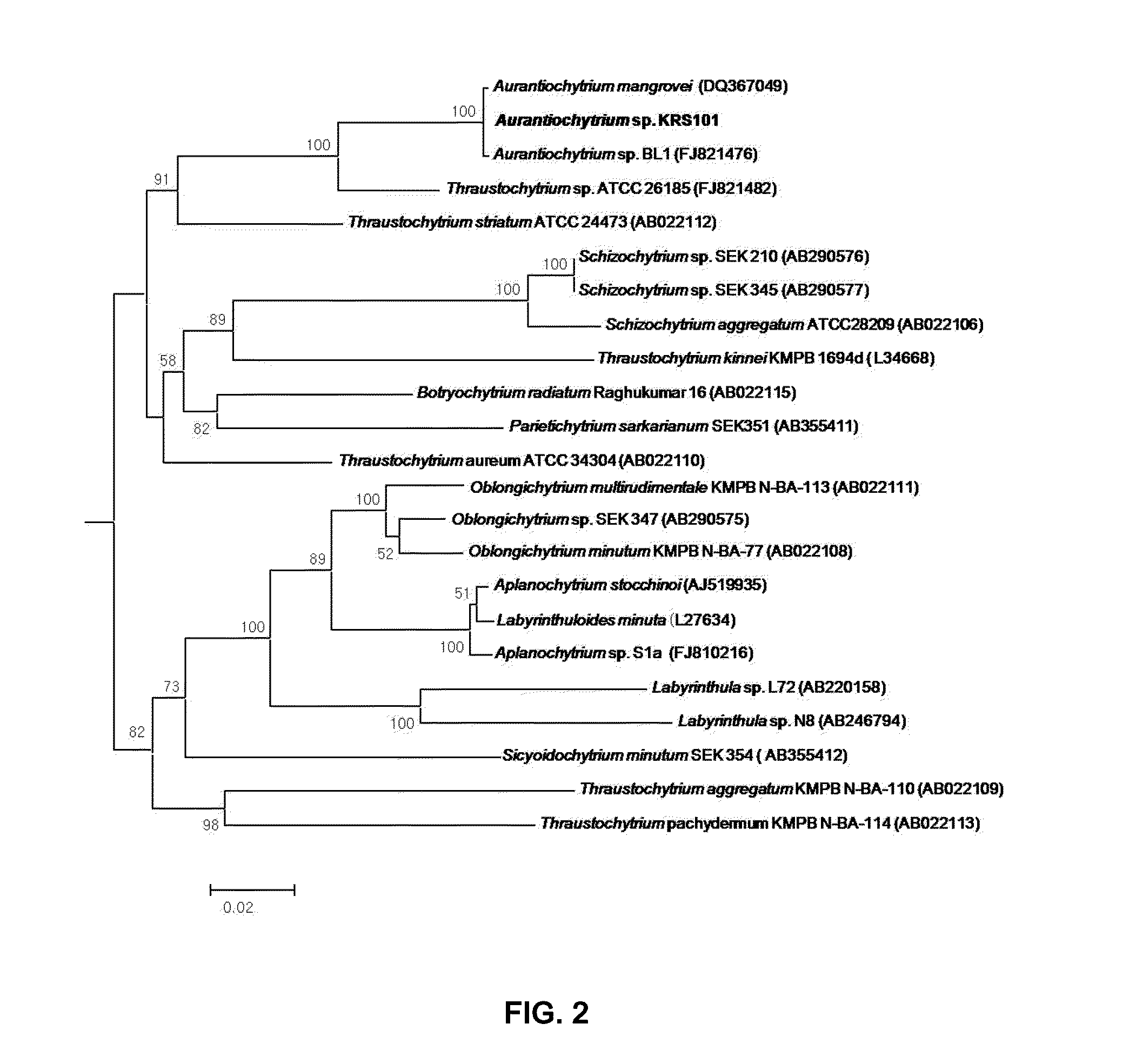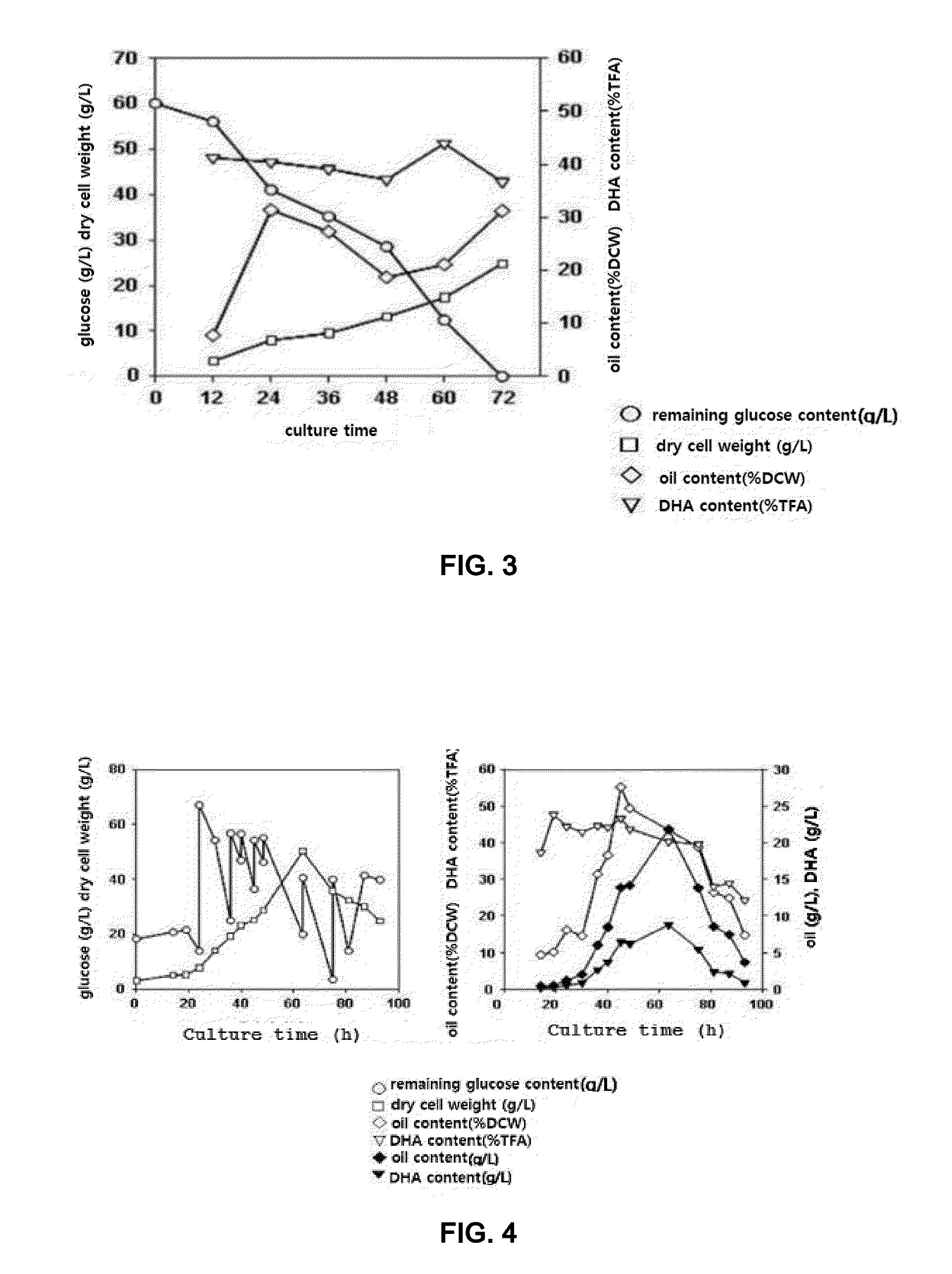Novel thraustochytrid-based microalgae, and method for preparing bio-oil by using same
- Summary
- Abstract
- Description
- Claims
- Application Information
AI Technical Summary
Benefits of technology
Problems solved by technology
Method used
Image
Examples
example 1
Isolation and Identification of Novel Oily Microalgae Containing DHA
[0052]A leaf / soil sample was collected in a mangrove area in Malaysia using a 50-ml falcon tube and suspended in 10 ml of saline, after which the suspension was diluted suitably and inoculated in B1 medium (solution of 1 g / L yeast extract, 1 g / L peptone and 10 g / L agar in 1 L of natural seawater containing 300 mg / L penicillin G and 500 mg / L streptomycin sulfate) (Burja et al. 2006) for isolation of thraustochytrid microalgae. The medium was incubated at 28° C. at 200 rpm for 2-4 days, and the obtained colonies were inoculated again in B1 medium. Then, the colonies were observed with a microscope, and 30 colonies were isolated, which formed zoospores which are the typical characteristics of thraustochytrid microalgae (see FIG. 1).
[0053]The 30 isolated colonies were cultured in 50 mL of a marine broth (Sigma-Aldrich) (250-mL flask) at 28° C. at 120 rpm for 3 days, and then the cells were collected and dried in a vacuu...
example 2
Analysis of the Cell Growth of Novel Thraustochytrid-Like Microalgae KRS101 and the Ability of the Microalgae to Produce DHA-Containing Oil
[0058]The cell growth of novel thraustochytrid-like microalgae KRS101 isolated in Example 1 and the ability of the microalgae to produce DHA-containing oil were examined under the conditions of various nutrient sources.
[0059]As a basal medium, a medium containing 60 g / L of the carbon source glucose, 1 g / L of the nitrogen source yeast extract and 6 g / L of artificial seawater salt was used. A single colony was pre-cultured in 15 ml of a basal medium at 28° C. at 120 rpm for 3 days, after which 1 ml of the culture broth was inoculated into media containing various concentrations of a carbon source, a nitrogen source and a seawater salt and was cultured at 28° C. at 120 rpm for 3 days. The cells collected by centrifugation were washed three times with PBS buffer (phosphate buffered saline, pH 7.2) and dried at 60° C. for 12 hours, and the dry cell we...
example 3
Ability of Thraustochytrid-Like Microalgae KRS101 to Use Various Nutrient Sources
[0071]The ability of thraustochytrid-like microalgae KRS101 to use various nutrient sources was examined. Specifically, the microalgal strain KRS101 was cultured in basal media containing various carbon sources, nitrogen sources or non-chlorine salts in the same manner as described above, and the cell growth and the contents of oil and DHA were examined.
[0072]The microalgal strain KRS101 was cultured in media containing 60 g / L of fructose, arabinose, xylose, lactose, maltose, sucrose, glycerol or crude glycerol as a carbon source in place of glucose. As a result, as can be seen in Table 5, the cell growth of the microalgal strain KRS101 was still possible in the media, even though it decreased compared to that in the media containing glucose. Particularly, the use of the biodiesel waste crude glycerol as the carbon source showed higher cell growth than the use of pure glycerol.
TABLE 5Cell growth and DHA...
PUM
 Login to View More
Login to View More Abstract
Description
Claims
Application Information
 Login to View More
Login to View More - R&D
- Intellectual Property
- Life Sciences
- Materials
- Tech Scout
- Unparalleled Data Quality
- Higher Quality Content
- 60% Fewer Hallucinations
Browse by: Latest US Patents, China's latest patents, Technical Efficacy Thesaurus, Application Domain, Technology Topic, Popular Technical Reports.
© 2025 PatSnap. All rights reserved.Legal|Privacy policy|Modern Slavery Act Transparency Statement|Sitemap|About US| Contact US: help@patsnap.com



